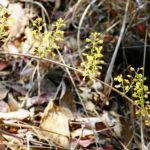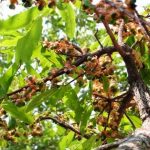TREE LIFE
November 2005
MASHONALAND CALENDAR
Tuesday 1st November: Botanic Garden walk. Subject ‘Trees in Flower’. Meet Tom in the car park at 4.45 for 5 pm.
Sunday 20th November: Please phone Mark or Maureen for details of this month’s outing, and to arrange lifts if necessary. Our hosts are Alodo and Alison Carli in the Arcturus area. We assemble at 9.30 a.m.
Bring you chair and lunch etc. Alison’s phone no. is 883138 and cell: 091-363-353.
Saturday 26 th November:
Maia and Rolf Chenaux Repond have kindly agreed to host Mark’s walk this month at their beautiful property, 32 Trafalgar Ave Sentosa.
We will meet as usual at 3.30pm. Because of the heat, Rolf Chenaux Repond, our host for Mark’s Walk has suggested that the walk start at 3.30 instead of 2.30. It certainly makes sense, so see you at 3.30
Apart from 40 species of trees, Rolf will show us some places where birds are nesting and sitting on eggs in his garden.
Sunday 27th November: Members are invited to attend THE NATURAL HISTORY TREASURES OF MATABELELAND
The Fifth Symposium under the auspices of the Aloe, Cactus and Succulent Society of Zimbabwe and the National Herbarium and Botanic Garden.
From 8am to 4.30pm at the Education Centre National Botanic Garden 5th street extension (southern gate manned parking area) Harare
NOMINAL CHARGE payable at the door of $ 60 000 per person.
Speakers
(30 minute presentations, most illustrated) include Peter Mundy (Birds), Viv Wilson (Mammals), Don Broadley (Reptiles), Alan Gardiner (Butterflies and Insects), Meg Coates-Palgrave (Trees), Ian McCausland (Geography), Gavin Stephens (World Heritage Aspects), Russell Taylor (Wild Life issues and Human/Animal Conflicts), etc. Please bring a chair and your own picnic lunch or use the Garden Restaurant.
Morning Tea will be provided for a small charge. There will be a donation box with all proceeds going to the National Botanic Garden Development Fund.
MATABELELAND CALENDAR
Please contact Jean Wiley or Gill Short for details of the next Matabeleland function.
SHOW AND TELL: SUNDAY, OCTOBER 2ND, 2005
16 people attended the Society’s first Show and Tell evening. The idea was taken from the Members’ Evening of the Suffolk Naturalists’ Society, where members bring pictures, slides, live specimens, books – anything that might interest other members.
Although an experiment, I think the evening went very well. Illustrated talks were given by Ian Riddell and Werner Fibeck, I demonstrated the Flora of Zimbabwe web site, which Bart Wursten and I have been working on, and some members brought along plant specimens for discussion. The evening was quite informal and enabled questions to be asked and discussions to take place in a relaxed atmosphere.
We hope to repeat the idea in about 6 months time – perhaps in March? – so next time, dust down your slides or jpegs and come along and share your knowledge!
-Mark Hyde
Here’s a response to Bindura bamboo & mannikins. Tree Life 307 October 2005
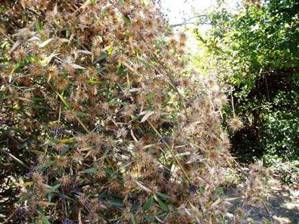
Oxytenanthera abyssinica. Photo: Mark Hyde. Source: Flora of Zimbabwe
Magpie Mannikins & the Botanic Gardens June Searson’s letter about Bindura Bamboo Oxytenanthera abyssinica & Magpie Mannikins (as they are now called) in the October Tree Life was most interesting.
And yes, the mannikins have visited the flowering bamboo in the Botanic Gardens. We first noticed them in December 2004 and on 1st January 2005 there were about 20 birds counted. The last time I went there and saw the birds was in March but I have checked with a more regular bird watcher and can report that in September they were building a nest in a conifer near the herbarium fish pond. September is an earlier date than previously recorded in Zimbabwe.
They are wanderers and closely associated with the bamboo though on the Mozambique coast they associate with rice cultivation (Birds of Africa Vol 7). To find flowering bamboo they must be great wanderers & could be overlooked but they also eat grass sap & seeds, millet/rice, herbs and Spirogyra algae. Some of the grass seeds are Panicum, Sorghum, Poa, Sporobolus and Eragrostis, and also seeds of Bidens pilosa the blackjack as well as other vegetable matter.
So it looks like they will hang around the Gardens until the bamboos finish flowering and hopefully raise some chicks in the mean time.
-Ian Riddell
ACACIA: THE NAME IS LOST TO AFRICA
In two earlier articles for Tree Life, I described the proposed changes to the genus Acacia. There were two elements of the change: scientific evidence suggesting the need to split Acacia into smaller genera and secondly an Australian proposal to reserve the name Acacia (in the new narrow sense) for the native Australian “wattles”.
No-one is particularly arguing with the first proposal, but the second one has ignited greater controversy. Since my earlier articles, there have been further developments on the second issue and these are the subject of this note.
My thanks go to Jonathan Timberlake who alerted me to the recent events and also to Caro Peech for giving me a copy of an article based on a paper by Dr. Siro Masinde, head of the East African Herbarium in Kenya.
As readers may recall, the scientific evidence suggests that Acacia sensu lato should be split into at least 5 genera, one of which would still be called Acacia, although it would be based on a narrower concept.
All such nomenclatural changes must take place in accordance with the International Code of Botanical Nomenclature (ICBN). Under normal circumstances, the position of the type species of Acacia (which is Acacia nilotica) would determine which new genus would retain the name Acacia.
If this normal approach were followed, then in Africa, our species would be shared among Acacia sensu stricto and a new genus Senegalia. For the Australians, there would be a wholesale change of their 968 wattles to another new genus Racosperma.
However, proposals were put forward by the Australians to change the type species for Acacia to an Australian species (specifically Acacia penninervum, a wattle). The effect of this proposal would be that the Australian acacias would retain the name Acacia and all other species would need to be put into new genera. In effect, Africa would lose the name Acacia, except for a few introduced wattles.
The arguments for and against this change have been discussed in my earlier articles. Procedurally, the proposal was put to two committees of the International Botanical Congress (“IBC”). The IBC Permanent Committee for Spermatophyta endorsed the proposal to re-typify Acacia by a majority of 9-6. Then the IBC General Committee also supported the move by an overwhelming majority of 14-6.
The final stage was to put the change to the IBC Nomenclature Section by a secret ballot at the international botanical congress held in Vienna on July 16th 2005.
For some reason, an enhanced majority (of 60%) was required to overturn the proposal endorsed by the Committee for Spermatophyta and the General Committee.
The voting on 16 July was 203 (45,1%) delegates in favour of the motion to re-typify Acacia and 247 (54,9%) were against. However, despite the majority in favour of rejection, the required 60% needed to overturn the motion was not achieved. Hence the proposal to re-typify Acacia went through.
Dr. Masinde comments that it is more usual for an enhanced majority to be required when a change is proposed to the status quo rather than to maintaining it.
This part of the process does indeed seem somewhat questionable.
It is unlikely that this process will ever be overturned as there is no procedure for “de-conserving” a name once it has been done. Furthermore, the next IBC meeting will be in Australia in 2010, which I’d have thought makes it even less likely.
So that is it – the decision has been made – and only wattles are Acacias!
All there is to do now is to wait for the scientific aspects to be clarified. All our native acacias will now (I think) become species within Senegalia or Vachellia. I don’t know whether the necessary combinations have been made – but I’m sure someone will rush to do those where necessary. We won’t have to change the names of (for example) Acacia dealbata (the Silver wattle) or Acacia melanoxylon (the Blackwood)!
The alternative of course to following the scientists is to simply retain Acacia for all practical purposes.
If I can obtain a list of the new combinations in Acacia, I’ll put them into a future article in Tree Life.
-Mark Hyde
RUZAWI SCHOOL, MARONDERA: 18 SEPTEMBER 2005
To organise a long-distance outing at a time of severe fuel shortages might be thought to be rather foolish, but we had a reasonable turnout of 12 members, which, together with our hosts made 14. Once again, we used the beautiful home and garden of Buck and Maureen Williams as a base and we are very grateful to them for their hospitality and guidance.
After tea in the beautiful shade of the garden, we drove a short distance into some Brachystegia woodland, still on the Ruzawi estate. It was a hot day, dry on the ground with little herbaceous vegetation but with trees beginning to come to life all over the place. The woodland was mainly of the miombo type and consisted of msasa and munondo trees and Uapaca kirkiana. The rocky hills were too low to support the Mountain acacia. The trees were covered in long hanging lichens as is typical in this high rainfall area and the altitude was also fairly high (1620 m or 5300 ft).
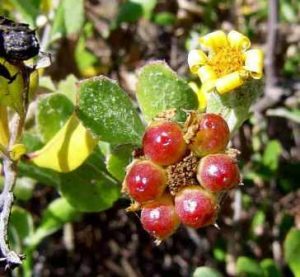
Chrysanthemoides monilifera subsp. septentrionale. Photo; Bart Wursten. Source: Flora of Zimbabwe
In the shrub layer there was abundant Helichrysum kraussii (the curry bush) which tends to favour poor sandy soils and also the yellow flowering composite, Chrysanthemoides monilifera subsp. septentrionale. The latter is widespread from the Cape northwards to E Africa and is divided into a number of species; ours is one from the north of its area (septentrionale means northern). It is very unusual for a composite in that it has fruits which are berries – quite unlike the usual dry wind-borne fruits of this family.
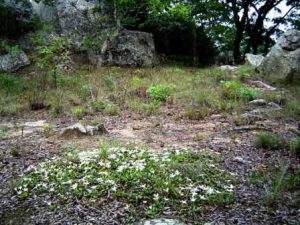
Leptactina benguelensis. Photo: Bart Wursten. Source: Flora of Zimbabwe
Also at ground level there were the leaves of the Ivory carpet, Leptactina benguelensis. This is a fairly common suffrutex in miombo woodland; at this time of the year, little was happening but buds were seen and these will burst into spectacular white flower as soon as the first rains come. It is a Rubiaceae, which means that it has opposite leaves and interpetiolar stipules. The fruits are orange and are edible.
In the shrub layer was Protea angolensis, the Angola protea. This is one of the three widely distributed proteas in this country. It has relatively large heads and broad, grey and hairless leaves. Again, this is quite a pretty species with its large white flower heads.
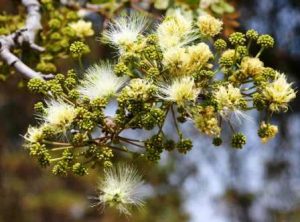
Albizia antunesiana. Photo: Bart Wursten. Source: Flora of Zimbabwe
Parinari curatellifolia, the Mobola plum or Hissing tree was generally common. Buck’s explanation of the name “Hissing tree” is that if you cut the tree down, the rising sap hisses as it escapes from the cut area.
Albizia antunesiana, the Purple-leaved albizia, was in beautiful flower. This has the powder-puff heads of albizias and it flowers when leafless, thus providing a splash of pale yellow colour in the dry woodland. A slightly more unusual flowering species was the Granite ochna, Ochna puberula, which was flowering everywhere. Ochnas tend to flower for very short periods and it is unusual to catch one in the act – and here there were many small plants with very spectacular yellow flowers.
Amongst the rocks on a small hill was the Granite garcinia (Garcinia buchananii) in flower. I can’t remember ever having seen this before. The flowers are yellow and quite large with 4 petals arranged in a cross shape and have waxy appearance. Also flowering were the spikes of flowers of Lannea discolor. These stick out in clusters from the tips of the rather thick branches.
As an indication of the high rainfall nature of the area was the presence of Cussonia spicata, a species most common in the Eastern Highlands but also found extending westwards along the main watershed and sporadically on rocky hills elsewhere. We also saw Cussonia natalensis in flower – but failed to see the commonest species of all, namely Cussonia arborea.
After a very pleasant lunch on the Williams’ lawn, a few of us set off in the afternoon for a short walk nearby. This was also quite interesting with a number of new species encountered which we hadn’t seen in the morning. One was Olinia vanguerioides, a high rainfall species of rocky places. It has the look of a Rubiaceae with opposite leaves and red petioles. We see it from time to time – e.g. on Domboshawa.
The weedy pine, Pinus patula was also just coming into flower and we were able to examine the separate male and female inflorescences. This exotic species is a major invader of the Eastern Highlands and it will also seed itself in higher rainfall areas elsewhere – e.g. near Ruzawi – and even near Harare occasionally. Also near Harare we get naturalised Pinus roxburghii, for example at Cleveland Dam. There are also records of Pinus taeda. It is always worth looking closely at escaped pines in this country.
As always, a day like this is a mental and physical tonic, helping us to overcome (or at least to forget for the time being) the frustrations of daily life. Our thanks go to Maureen and Buck for the warm welcome and contribution in so many ways throughout the day. We look forward to another visit some time in the future.
-Mark Hyde
PS For those with internet access, a full list of the 72 plant species seen on this outing may be found on the Flora of Zimbabwe web site. To access this, go to:
https://www.zimbabweflora.co.zw /speciesdata/utilities/index.php and enter the date of the outing in the boxes below the section marked: “Extract a list of records from a particular date:”
THE PEEPUL TREE OF HARARE’S PUBLIC GARDENS
But it was Buddhism that raised the Bo tree into a special class of its own, as a living symbol of the faith that spread to almost every part of Asia… A rich fabric of myth has grown around the tree, and also around the events that transpired under it.
WILLIAM WARREN (1986) –
ASIA’S MOST SACRED TREE
The Indian Prince Siddharta of the noble Guatama family renounced the material comforts of his life, and at the age of 29 began his search for spiritual enlightenment. He studied with the Brahmans, but remained unconvinced that the right path was to be found in their teachings, and still less in the self-inflicted tortures of the Fakirs. He tried all the common methods of the time, but nothing brought fulfilment. At last, in 596 BC at the age of 36, he came to a place called Uruvela – now known as Buddhagaya – where a great peepul tree grew on the banks of a river. Siddharta sat and meditated under this tree for weeks – some say seven days, others say seven years – until he achieved the enlightenment (bodhi) that brought him Buddhahood. The tree under which he sat is known to Buddhists as bodhidruma, bodhi tree, or bo tree – the tree of enlightenment – and, to the devout, the place where it stood is the centre of the earth. Prince Siddharta is now better known as Guatama Buddha, and his bo tree is said to have lived for 272 years after his death in the 5th century BC. A direct descendant of the original bo tree was planted as a seedling in the ancient city of Anuradhapura in Sri Lanka, which became the centre of Buddhism after the faith declined in India. The seedling was carried from Buddhagaya by Princess Sanghamitta in 288 BC, which makes it the oldest historical tree in the world, and every year of its existence has been carefully recorded.
The peepul tree – also spelt pipul or pipal – is known to science as Ficus religiosa. It is venerated by Hindus as well as Buddhists, and is often planted near temples and wells in India and Burma. In the forest it is a destructive epiphyte – a plant that clings to another for support but is not parasitic – and it does much harm to buildings, sending its roots into any crevices in them. But the Hindus regard its as sinful to kill these trees, so they are rarely felled in spite of the damage they cause.
A large, multistemmed peepul tree stands in the middle of Harare’s Public Gardens. There is no record of when it was planted, but it must have been by about 1915. In October 1986 it was 15 metres tall, with a diameter at ground level of 2.4 metres, and a crown spread of 25 metres. There are other specimens nearby, but none as large as this one.
-Lyn Mullin
THE SETTLERS TREE
The Umtali Railway Station was the scene of much excitement at four o’clock in the afternoon of 12 August 1907, when a train pulled in from Beira carrying the Crown Prince of Portugal, Don Luiz Filipe, Duke of Braganza. The band of the local unit of the Southern Rhodesia Volunteers played the Portuguese National Anthem, and a royal salute was fired by the British South Africa Police. The Duke and his retinue were met by the Acting Administrator of Southern Rhodesia, The Hon Sir Thomas C Scanlen, KCMG, Members of the Executive Council, and heads of various Government departments, who had travelled from Salisbury by train the previous day accompanied by 20 members of the BSA Police. After inspecting the Guard of Honour the Prince rode through the gaily decorated streets of Umtali to the Court House, where His Royal Highness planted a tree in front of the building. A plaque was placed before the tree bearing the legend
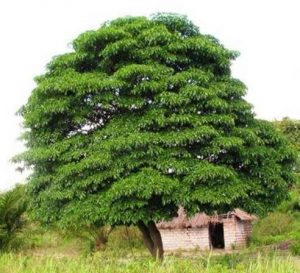
Rauvolfia inebrians. Photo: Jos Stevens. Source: Flora of Zimbabwe
HIS ROYAL HIGHNESS DON LUIZ FILIPE
DUKE OF BRAGANZA
AND CROWN PRINCE OF PORTUGAL
PLANTED THIS TREE
(RAUVOLFIA INEBRIANS)
ON THE 12TH AUGUST, 1907,
TO MARK THE OCCASION OF HIS
VISIT TO UMTALI
The tree, the plaque, and the magistrates’ court are still there, but much else has changed since that day – Southern Rhodesia has become Zimbabwe, Umtali has become Mutare, Salisbury has become Harare, and Rauvolfia inebrians has become Rauvolfia caffra. The species is widespread along river fringes at medium altitudes in Zimbabwe, and also in the evergreen forests of the Eastern Highlands, where it sometimes grows to heights of 40 metres or more. It has a number of Shona names – mukamamasanhi, mukashu, mukauroro, musingwiswi, mutowamakaka, dzurungu, muzungurwi – but in English it is simply known as rauvolfia, or occasionally as quinine tree in allusion to the very bitter, milky sap.
The Settlers Tree is a poor specimen of its kind, and by June 1987 had reached a height of only about 5 metres and a diameter of 42 centimetres. It was forked just above breast height, and had had a large limb removed at some time in the past. It stands on Aerodrome Road (formerly Victory Avenue) in Mutare, directly in front of the police charge office.
Why the name “Settlers Tree”? I have never been able to find out!
-Lyn Mullin
Wanted: articles for Tree Life …
TREE LIFE NEEDS YOU – or rather it needs your input. Articles, notes, comments, questions, observations – all are welcome. Your contribution needn’t be long or weighty – a simple note or observation is often of great interest.
Don’t be put off by thinking you don’t know enough. Sit down and pen something today!
Mark Hyde
MARK HYDE CHAIRMAN


